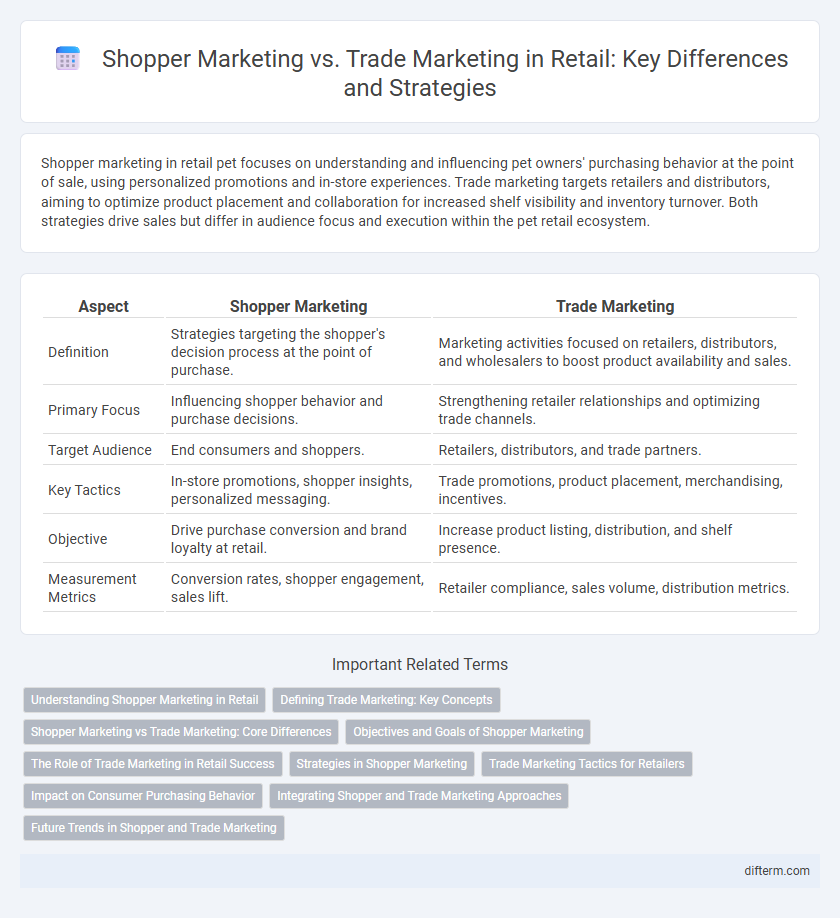Shopper marketing in retail pet focuses on understanding and influencing pet owners' purchasing behavior at the point of sale, using personalized promotions and in-store experiences. Trade marketing targets retailers and distributors, aiming to optimize product placement and collaboration for increased shelf visibility and inventory turnover. Both strategies drive sales but differ in audience focus and execution within the pet retail ecosystem.
Table of Comparison
| Aspect | Shopper Marketing | Trade Marketing |
|---|---|---|
| Definition | Strategies targeting the shopper's decision process at the point of purchase. | Marketing activities focused on retailers, distributors, and wholesalers to boost product availability and sales. |
| Primary Focus | Influencing shopper behavior and purchase decisions. | Strengthening retailer relationships and optimizing trade channels. |
| Target Audience | End consumers and shoppers. | Retailers, distributors, and trade partners. |
| Key Tactics | In-store promotions, shopper insights, personalized messaging. | Trade promotions, product placement, merchandising, incentives. |
| Objective | Drive purchase conversion and brand loyalty at retail. | Increase product listing, distribution, and shelf presence. |
| Measurement Metrics | Conversion rates, shopper engagement, sales lift. | Retailer compliance, sales volume, distribution metrics. |
Understanding Shopper Marketing in Retail
Shopper marketing in retail focuses on understanding consumer behavior at the point of purchase, leveraging insights to influence shopping decisions and enhance the overall buying experience. It involves targeted promotions, in-store displays, and personalized messaging to drive immediate sales and brand loyalty. This approach contrasts with trade marketing, which primarily targets retailers and distributors to optimize product placement and supply chain effectiveness.
Defining Trade Marketing: Key Concepts
Trade marketing focuses on building strong relationships between manufacturers and retailers to optimize product placement, promotions, and shelf visibility. It involves strategies such as category management, point-of-sale displays, and retailer incentives aimed at increasing product demand within the retail environment. Effective trade marketing drives sales growth by ensuring products reach consumers through well-organized retail channels and maximized in-store presence.
Shopper Marketing vs Trade Marketing: Core Differences
Shopper marketing targets the end consumer's behavior and preferences at the point of purchase, emphasizing in-store experiences and promotional tactics to influence buying decisions. Trade marketing focuses on building relationships and strategies with retailers and distributors to ensure product availability, visibility, and support within retail channels. The core difference lies in shopper marketing's direct focus on shopper engagement, while trade marketing centers on optimizing supply chain and retail partnerships.
Objectives and Goals of Shopper Marketing
Shopper marketing aims to influence consumers' purchasing decisions directly at the point of sale by understanding shopper behavior and driving immediate sales conversion. Its objectives include enhancing the in-store experience, increasing product visibility, and fostering brand loyalty through targeted promotions and personalized communication. Emphasizing shopper engagement and emotional connection, shopper marketing seeks to convert shoppers into buyers by aligning marketing strategies with the shopper's path to purchase.
The Role of Trade Marketing in Retail Success
Trade marketing plays a critical role in retail success by bridging the gap between manufacturers and retailers, ensuring effective product placement and promotional strategies that drive sales. It focuses on optimizing in-store execution, category management, and retailer partnerships to enhance product visibility and shopper experience. By aligning manufacturer objectives with retailer goals, trade marketing maximizes shelf impact and inventory turnover, directly influencing retail profitability and shopper satisfaction.
Strategies in Shopper Marketing
Shopper marketing strategies focus on understanding consumer behavior at the point of purchase, leveraging data insights to create personalized experiences that drive conversion and loyalty. Techniques include in-store promotions, digital engagement through mobile apps, interactive displays, and targeted sampling to influence purchase decisions directly. Emphasizing shopper-centric tactics enhances brand visibility and encourages repeat buying by aligning marketing efforts with consumers' needs and preferences in retail environments.
Trade Marketing Tactics for Retailers
Trade marketing tactics for retailers emphasize building strong partnerships with suppliers through cooperative advertising, in-store promotions, and exclusive product launches. Leveraging point-of-sale displays and data-driven merchandising strategies enhances product visibility and drives shopper engagement at retail locations. Efficient inventory management and targeted retailer incentives optimize shelf space utilization and maximize sales performance.
Impact on Consumer Purchasing Behavior
Shopper marketing directly influences consumer purchasing behavior by targeting shoppers at the point of sale through personalized promotions and in-store experiences, increasing the likelihood of immediate purchase decisions. Trade marketing, focusing on building strong relationships with retailers and enhancing product placement and visibility, indirectly affects consumer behavior by optimizing product availability and shelf prominence. Combining both strategies maximizes consumer engagement and drives higher sales conversion rates by aligning retailer incentives with shopper motivations.
Integrating Shopper and Trade Marketing Approaches
Integrating shopper marketing and trade marketing approaches enhances retail effectiveness by aligning in-store promotions with retailer partnerships, driving both consumer engagement and distribution strength. Utilizing shopper insights to tailor trade marketing strategies improves product placement, pricing, and promotional tactics, resulting in increased sales and brand loyalty. Streamlining collaboration between these functions fosters a seamless customer journey from awareness to purchase, maximizing return on marketing investment.
Future Trends in Shopper and Trade Marketing
Future trends in shopper and trade marketing emphasize the integration of artificial intelligence and big data analytics to deliver personalized shopping experiences and optimize inventory management. Omnichannel strategies will become essential, blending in-store and digital touchpoints to meet evolving consumer preferences efficiently. Sustainability and ethical sourcing are increasingly influencing shopper engagement and trade partnerships, driving transparency across the retail supply chain.
shopper marketing vs trade marketing Infographic

 difterm.com
difterm.com